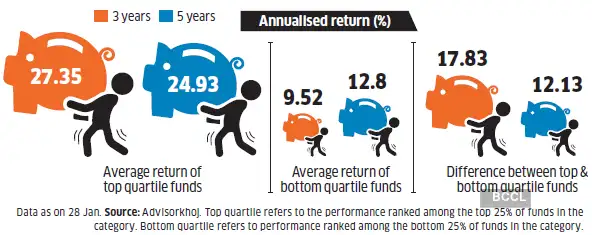Data suggests that this category boasts the most divergent outcomes among all equity and hybrid fund categories. According to Advisorkhoj, the difference in average returns of the top quartile ranked funds relative to the bottom quartile funds in this category stands at 17.8% and 12.13% over the last three and five years, respectively. By contrast, the gap between the top and bottom quartile funds in the flexi-cap category stands at 12.98% (three years) and 10.63% (five years). For dynamic asset allocation funds, the gap is narrower at 8.33% and 6.47% for the corresponding time periods.
What makes multi-asset funds’ performance vary so widely? All fund categories house schemes with differing investing styles and frameworks. This results in divergent outcomes within the categories. However, the distinctly sharp divergence in return profiles in multi-asset funds is owing to disparate positioning on multiple fronts. Santosh Joseph, CEO and Founder, Germinate Investor Services, asserts, “Multi-asset funds have been running differing strategies to solve the same problem. Many are still finding their feet in terms of the right approach.”
Schemes differ in three broad areas— asset allocation, risk-return profile and taxation. First is the choice of asset class. Earlier, multi-asset funds were plain vanilla offerings, combining the troika of equity, debt and gold. Most of the newer funds now include foreign equities and commodities too. Tata Multi Asset Opportunities was the first to add commodity derivatives. Nippon India Multi Asset Fund was the first to offer foreign equities and commodity derivatives. SBI Multi Asset Allocation Fund has a provision for investing in Real Estate Investment Trusts (REITs). This disparate asset mix contributes to the varying outcomes.
Multi-asset funds have exhibited highly disparate outcomes
The varied strategies run by funds have contributed to a big gulf in returns.

On the next level, the way fund managers decide and switch asset allocation is crucial. Funds either run a static or rule-based allocation to different asset classes. Many funds tend to maintain 65% allocation to domestic equities to qualify for the preferential lower taxation on capital gains. Offerings from Edelweiss AMC and WhiteOak Capital AMC run a higher tilt towards fixed income, with the equity exposure hedged via arbitrage. Individual funds running rule-based allocation have varying limits on exposure to each asset class. Within these limits, funds may opt for higher or lower allocation to a particular asset class at any time depending on their assessment. Joseph observes, “Some multi-asset funds have missed capturing the market upside in the past few years, even as others have managed to ride the uptick. This is why the returns are diverging so sharply.” Further, fund houses take different investing apapproaches within asset classes. For instance, within equities, some multi asset funds run a large cap bias (DSP Multi Asset, HDFC Multi Asset, Nippon Multi Asset). Others adopt a more flexi cap approach accommodating mid and small caps (SBI Multi Asset Allocation, Quant Multi Asset, Motilal Oswal Multi Asset).
What can investors do?
Multi-asset funds are actively promoted as a remedy against the hassle of predicting which asset classes will work well, and in what combination. Yet, the multi-asset strategy is not foolproof. The disparity in approach by individual funds and the resulting outcomes make the choice of funds in this space critical. Selecting the wrong fund will negate any potential benefits.
How can investors make a more informed choice? Experts insist that the big gulf in returns is likely to narrow down eventually as funds learn from past mistakes and find a sweet spot. It is best that investors let a multi-asset fund build a track record of performance before diving in. “Many of these funds have only just come into the picture. These will need time to refine their strategies,” insists Rushabh Desai, Founder, Rupee with Rushabh Investment Services.
Make sure you understand what the fund is trying to do. The purpose of a multi-asset strategy is to manage risk. The funds that emphasise on the risk construct rather than offer an edge in returns should be your pick. Joseph suggests, “Ascertain what fits your own risk profile. Which asset classes is the fund offering? Is it following static or rule-based allocation? Will it provide equity, non-equity or debt-like taxation?” Equity bias will help keep taxes lower and potentially fetch higher return, but at the cost of added volatility. Getting exposure to five or six different asset classes under a single roof seems appealing from the diversification perspective. However, it is not easy to pull off either. Desai remarks, “The more the asset classes on offer, the trickier it will be for the fund to deliver consistently.”








